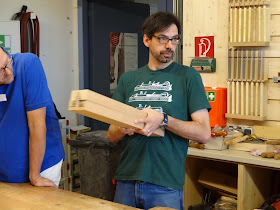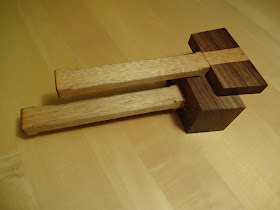If you haven't heard of Paul Sellers, he is one of the big names in hand tool woodworking at the moment. He has schools in both the UK and the US, and seems to be making a lot of converts to hand tool woodworking by cutting out much of the B.S. and marketing prevalent in many publications today.
I'll not argue with his results. I'll not argue with his vast experience. I'll not argue with his success, nor the success of his students. I really don't want to argue with him at all!
Paul Sellers is good for woodworking today, as he has been able to reach a lot of people. I love his YouTube videos.
Paul Sellers is a big fan of the Stanley #4. Older ones, not the new ones. I can't argue with what he does with that tool. One of his best YouTube series is about making a workbench in the back yard with home center lumber, and the only plane he uses is a #4. Brilliant.
His blog today has a question from one of his readers on whether or not a bevel up plane is a good first plane, as many state. He argues that a woodworker's first plane should be a #4, that it is much more versatile than a bevel up plane, and argues with the fact that a 25 degrees is much too low for a plane like this.
Here is my take. I advocate a first plane being a jack plane, and a bevel up jack is a more-than-valid choice. But not the only one. You can read about why I think this in a post I did a while back about what I think should be in a beginner's tool kit. Essentially, you can fudge both smoothing and jointing with a jack plane without too much new to learn.
I think jointing with a #4 smoothing plane is something that a beginning woodworker may have a little more trouble getting the hang of.
Oftentimes for beginners, cost is also prohibitive. Here is where Paul wins big points. An old, rusty smooth plane can be purchased for the fraction of the cost of a new Lie-Nielsen. But, let's look a bit closer. He also advocates in this article getting a #5, a #4 1/2, and a #5 1/2. I'll agree that in the UK you can get these four planes in good shape for a lot less. But, in the US getting these planes in the kind of shape that you will be able to get working as a beginner might cost quite a bit more than a brand new bevel up jack. I think the big advantage here goes to the premium manufacturer.
 |
| My Veritas BU jack in action |
Also a word about the 25 degree thing. I grind my BU jack blade at 25 degrees (or so). The reason I do this is because of the way I sharpen. I think that this is probably what most BU enthusiasts also do. I sharpen and hone a microbevel at 30 degrees. This is the angle that Paul Sellers recommends. His method for sharpening is a lot different than mine, but we both get to the same angle when the blade hits the wood. I know people who use and swear by his method. If it gets to sharp, and you can do it, then you are doing it right, in my book.
The real versatility with this BU jack is the fact that it is so easy to make that microbevel any angle you want. What I do is have a few different blades sharpened at different angles depending on what the application is. Changing the angle on a bevel down plane involves back bevels.
In conclusion, I think I will say there are many different ways a beginner can go with a plane intended for multiple uses. The argument for a bevel up plane is valid because in my opinion there is no better way to turn off a new woodworker than for him or her to think that it is too hard. Indeed there are skills to learn in order to build furniture (part of the fun), but adding skills needed to set up a finicky vintage tool to the mix might be one hurdle too many for the average newbie getting their only information from the internet. There isn't only one way to learn woodworking.
What are your thoughts?

























-00016016489432-HighRes.jpg)










